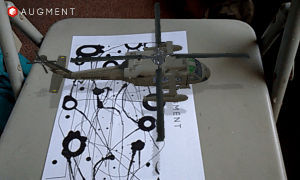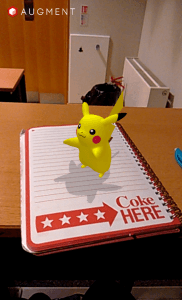This week we were looking at the basics of Augmented Reality. More commonly abbreviated as AR, the concept is continually growing and expanding towards public usage. First developed in 1990 by Professor Tom Caudell, AR has become increasingly relevant to the way we use technology both in our home, schools, workplaces etc.
How does it work?
The simplest type of Augmented Reality is one that is commonly used on apps (such as Augment) for mobile phones and other similar hardware. Augment uses printable ‘trackers’ that the user can place in an open area and have their CGI model displayed onto them. Augment in particular allows users to customise their own trackers, print out a pre-developed design or to scan an object that will become a tracker temporarily. The below images are rough demonstrations of how the application works.
The first image of the helicopter model is an example using one of Augment’s pre-developed trackers that I printed. By projecting my mobile phone in the direction of the A4 tracker after having selected the model, the app ‘picks up’ the design and uses it as a surface to display the helicopter on top. The second image is an example of using a temporary tracker to display the Pikachu model- my notebook suffices as a tracker as the shape and size is suitable to allow 3D models to be shown.
What are the benefits?
Although Augmented Reality is still in development, it has proved to be useful in both a creative and practical sense. Museums have been able to enhance their materials on display by using similar tracking points to show 3D models in addition to real-world objects. It gives users a new insight into how they are able to watch, read and learn about history and culture. AR can also be used for educational purposes, i.e. architecture students can model and view their building elements in real-time on a small and convenient scale. Medical students can be shown a display of the human body in a more intricate and reflective design compared to a 2D textbook image. Another use that has been revised recently is for customers shopping for new furniture in their home- AR models of a sofa can be projected into their living room, allowing them to gain a rough idea of what the overall look will be before purchase, for example. Finally, I could use AR in my own project to display models of things that relate to me or describe my personality.
Are there any flaws/drawbacks?
Currently, Augmented Reality is still in a somewhat prototype phase. Looking at the models above, they provide a somewhat detailed image, although they fail in terms of texturing. The technology could be further developed so that 3D models will appear more realistic and less animated. Another problem is that apps such as Augment only allow so much room for the models to be shown on a small scale, which can be inconvenient if a user wanted to display multiple models at a time.



Hello next Wednesday I am hosting a more in-depth workshop (5:30pm) on augmented reality where we will be making a bespoke AR app (not using third party apps).
Event details: https://techlincs.splashthat.com